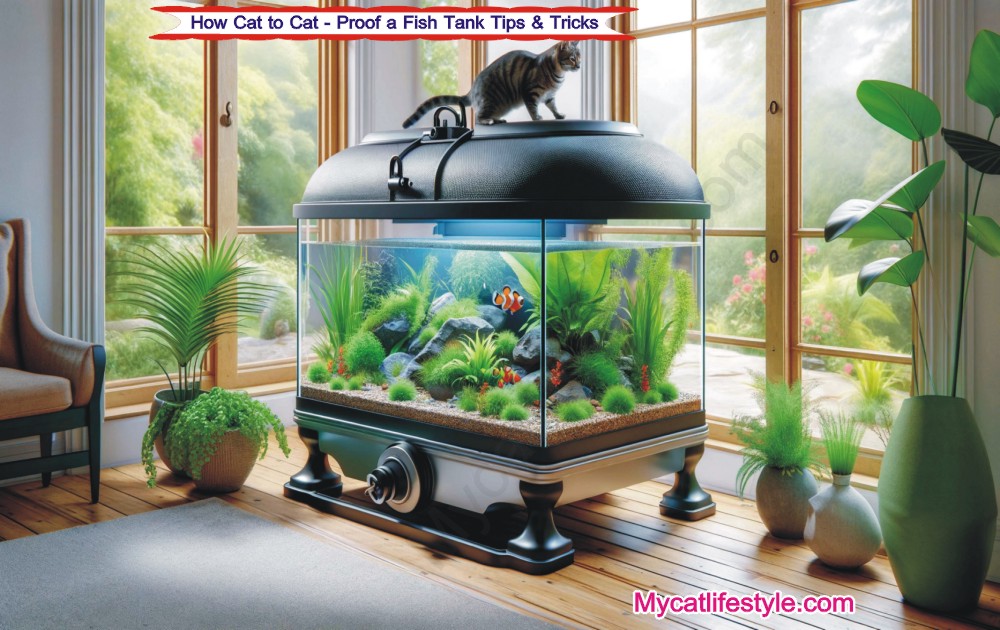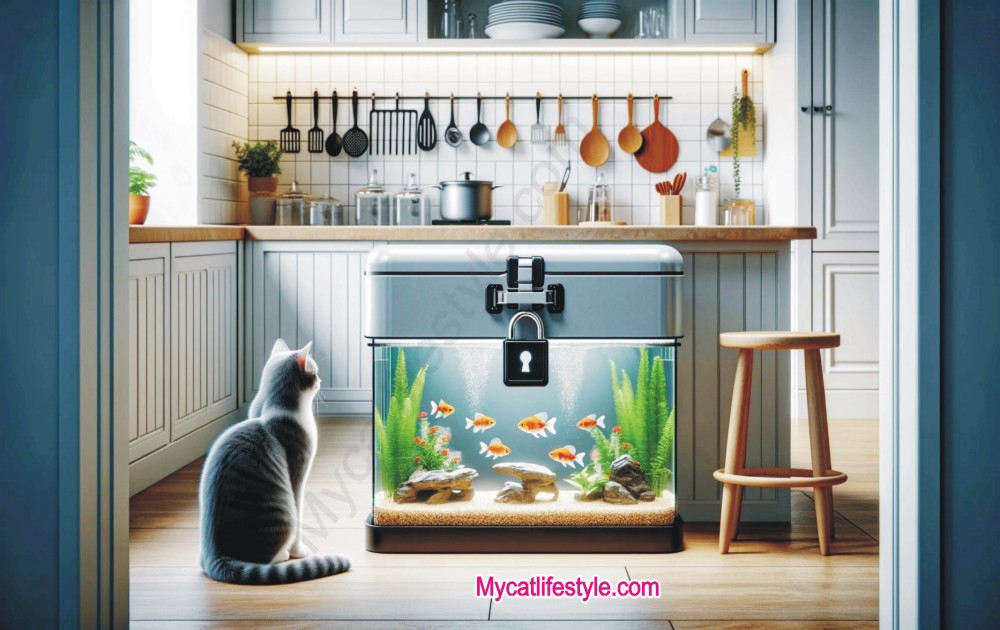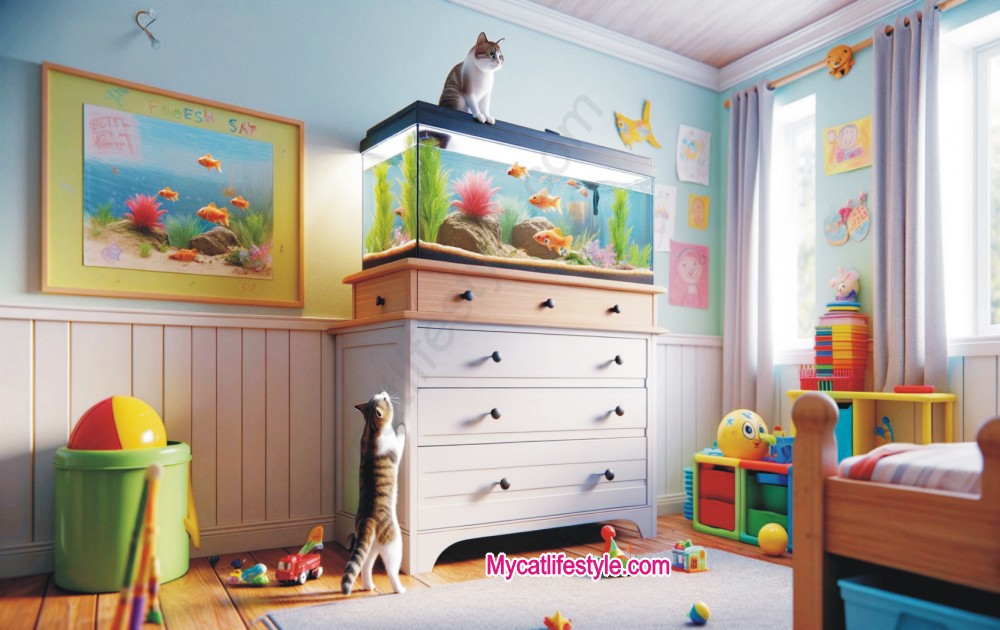How to Cat-Proof a Fish Tank: Vet Approved Tips & Tricks

Cats love watching and chasing fast, moving things, like the colorful fish swimming in your living room fish tank. Unfortunately, our cute cats don’t just watch from the side. They often try to get closer than they should.
You might find your cat in spots you didn’t even know they could reach. Even if your cat usually behaves well when you’re watching, your fish might still be in danger when you’re not there. To help keep your fish safe and not too stressed, here are seven ways to protect your fish tank from your curious cat.

The 7 Proven Ways: How to Cat-Proof a Fish Tank
Mesh Screen
To keep cats out of a fish tank, consider using a mesh screen to cover the opening. This stops your cat from jumping in and possibly hurting the fish. Place the mesh over the top of the tank to block the cat while still letting light and air through. The mesh should be small enough so the cat’s paw can’t fit through, but also strong enough to resist tearing. This helps prevent the cat from reaching in and grabbing the fish.
You can secure the mesh screen to the tank using clamps, ties, clips, or screws. Make sure it’s tightly fitted so your cat can’t push it aside and get into the tank.

Pros
Cons
Secure Tank Covering
Cats are naturally drawn to the lively fish in aquariums. When you’re not around, there’s nothing to stop your kitty from bothering the fish. A simple solution is to cover the tank while you’re at work or sleeping. Old blankets or towels are good for this. Use anything that conceals the fish from your cat. However, be cautious.
If your cat enjoys playing with fabric, like curtains or a blanket dangling from a bed, it might pull everything down. Ensure the blanket or towel and the tank are securely fastened. The last thing you want is a broken aquarium. If your cat likes to pull at fabric, consider using cardboard to cover the glass instead.
Pros
Cons
Cat Repellent
Certain scents can deter your cat from exploring specific areas. Cats generally dislike citrus smells like lemon, lime, and orange. You can also find commercial cat repellent sprays on the market—just remember to use them regularly. These scents need to be reapplied after they fade, or your cat might return to the area. Be very cautious to ensure that the repellent doesn’t contaminate the fish tank.
Pros
Cons
Cat-Proof Mats
Cat-proof mats are an excellent solution for keeping your cat away from your fish tank. There are various types available. Some mats have a spiky surface that cats dislike walking on. These mats are safe and straightforward to use. There are also shock-proof mats that emit low-powered, static-like electric pulses. While these pulses are harmless to cats and effective at preventing them from jumping into the aquarium, some pet owners find them inhumane.

Pros
Cons
Sticky Surfaces
Double-sided sticky tape can be used around the fish tank as a deterrent. Cats are selective about where they step, much like their preferences for certain types of litter. If you’ve ever walked on gravel or a rocky beach barefoot, you know how uncomfortable it can be. Cats feel similarly and will avoid surfaces they find unpleasant. Sticky surfaces work well because cats don’t like how the tape feels on their paws.
Pros
Cons
Set Up a Distraction
Distracting your cat can be effective, especially when combined with other methods. Keeping toys around while you’re away at work can keep your cat occupied. Puzzle toys filled with treats are particularly good at diverting their attention away from the fish tank. If you have a garden, placing a cat tree near a window that looks out onto it can also help. This gives your cat a high spot to watch birds and enjoy the view, keeping them entertained and away from the fish tank.
Pros
Cons
Aquariums With Lids
Not all fish tanks come with lids, but those that do offer several advantages. Lids help prevent fish from jumping out, keep dirt from entering, and can even support the growth of aquarium plants with integrated LED lights. Aesthetically, tanks with built-in lids often look better than other solutions.
While a secure lid won’t stop your cat from jumping on top of the tank, it will prevent them from reaching the fish inside. You might not be able to stop your cat from being intrigued by the fish, but you can make it impossible for them to get to them.
Pros
Cons
Close the Door
If other methods fail, consider keeping your fish tank in a room that can be closed off, especially when you are sleeping or not at home. It might feel harsh to restrict your cat’s access to parts of your home, and some cats may protest loudly when they are denied entry.
Make sure the room doesn’t contain essential items like your cat’s litter box. Over time, your cat will adapt and find other activities, such as sleeping or playing with other toys. Simply closing the door can be the most straightforward solution to prevent your cat from getting to the fish.

Pros
Cons
Why Are Cats Attracted to Fish Tanks?
Cat owners often notice their pets are fascinated by fish tanks, but what’s the reason behind this attraction? Despite many cats’ aversion to water, they seem drawn to aquariums. Here’s why:
Water Interaction
While most cats dislike being soaked, they may still enjoy interacting with water. You’ll recognize this behavior if your cat paws at water from a dripping faucet or plays with water in their bowl. In the wild, cats prefer drinking from flowing sources like streams, which might explain their interest in the sound of water from an aquarium filter. This sound alone can attract a cat, even if no fish are in the tank.
Natural Hunting Instincts
Cats are natural hunters, and the quick movements of fish darting around can instantly grab their attention and trigger their hunting instincts.
Seeking Warmth
Your cat might be drawn to the warmth if your fish tank is heated. Cats enjoy lying on or next to warm areas, although this can be risky as they could fall into the tank and scare the fish.
While cats might find fish tanks intriguing, it’s best to keep them apart for the safety of both pets and fish. Ensuring your cat doesn’t have access to the fish tank and providing them with other sources of entertainment can keep them happy and occupied elsewhere.

Frequently Asking Questions
How do I keep my cat off my fish tank?
To keep your cat off your fish tank, try using deterrents like double-sided tape or a cat-proof mat near the tank. You can also cover the tank with a sturdy lid.
How do I protect my fish from my cat?
Protect your fish by covering the tank with a secure lid and using cat repellents around the area. Keeping the tank in a room that’s usually closed can also help.
Can I have a fish tank if I have a cat?
Yes, you can have a fish tank if you have a cat. Just make sure to take precautions like securing the tank with a lid and using deterrents to keep the cat away.
Can cats open fish tank lids?
Some cats might be able to open fish tank lids if they are not secure enough. It’s important to ensure the lid is tight and possibly locked if your cat is particularly curious or persistent.
Conclusion
To sum up, by using the easy tips in this article, you can make your fish tank safe from your cat. These tips include putting a cover on the tank, using things to keep cats away, and keeping the aquarium room closed.
By doing these things, you can help stop your fish from becoming cat snacks. Always keep an eye on your pets when they’re near the tank to make sure they’re safe. Remember, a cat drinking water from a fish tank could also get sick.





